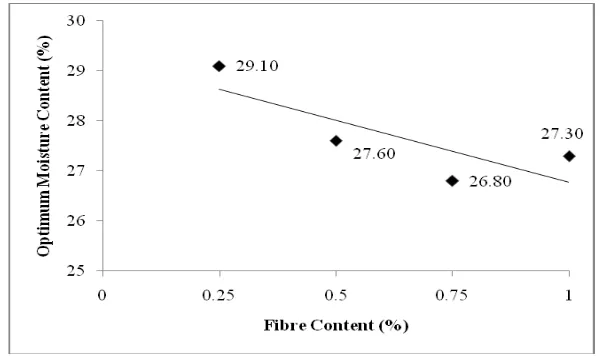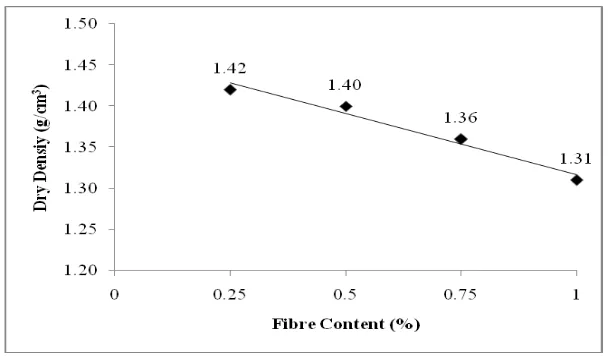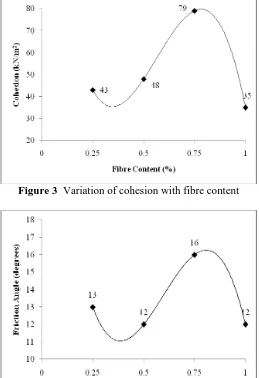68
THE EFFECT OF OIL PALM FIBRE ON
STRENGTH BEHAVIOUR OF SOIL
Zalipah Jamellodin*, Zaihasra Abu Talib, Roslan Kolop & Nurazuwa Md Noor
Faculty of Civil & Environmental Engineering, Universiti Tun Hussein Onn Malaysia, 86400 Parit Raja, Batu Pahat, Johor
*Email : zalipah@uthm.edu.my
ABSTRACT.
Construction over soft soils in this country is something that cannot be avoided due to the lack of available good bearing soil for construction. The modern techniques of reinforcing soft soils consist of continuous inclusions of synthetic strips, fabrics, and grids into an earth mass. The used of natural fibre such as oil palm fibre which is abundant in this country probably has the potential to be used as a cheaper version of soft soils reinforcement material. In this study, random inclusion of oil palm fibre (OPF) is investigated as a soil reinforcement method. Four different percentages of OPF, 0.25%, 0.5%, 0.75% and 1% by weight of raw soft soil are considered. The investigation covers the effect of OPF in soil on compaction and shear strength behaviour. The reinforced soil samples were subjected to compaction and triaxial compression tests. The results of these tests shown a significant improvement in the failure deviator stress and shear strength parameters (C and Φ) of the studied soil. It is observed that the fibres act to interlock particles and group of particles in a unitary coherent matrix thus increasing the strength properties of the soil.KEYWORDS
. Oil Palm Fibre; Soil reinforcement; Compression; Cohesion; FrictionINTRODUCTION
The foundation of any structures is depending on the types of soil. Before the construction take place it is importance to ensure that the soil condition is suitable with the building. Moisture content is the importance element that can affect the physical properties of the soil.
Soft soil improvement is the most important part in building construction and others engineering structure. Construction in soft clay will expose to several problem such as low bearing capacity and a high moisture content. This major problem will cause a lot of problem in structure construction such as crack and settlement. Soft saturated clay layers are often encountered at shallow depths below foundation. Depending on the structural load and the depth of the clay layer, unusually large consolidation may occur. Special soil-improvement techniques are required to minimize settlement. In this research was discussed about the stabilization of soil by admixtures of OPF as stabilization agent.
MATERIALS AND METHODS
Materials
Soil sample was collected from Research Centre for Soft Soil (RECESS) located near to the University of Tun Hussein Onn Malaysia (UTHM). The soils sample was collected in plastic bag to restore its moisture content. The dried soils are crushed with used rubber hammer and grinder machine. The fibre which is OPF was air dried to remove the moisture content from it. Untreated OPF was used for experimental study.
Preparation of samples
69
The investigation covers the effect of OPF in soil on density and shear strength behaviour. The reinforced soil samples were subjected to compaction and triaxial compression tests. All testing were also extended to the unreinforced soil specimen as control specimen to make a comparison with the reinforced soil.
Compaction test
A compaction test was carried out in this study for Light Manual Compaction Test according to BS 1377: Part 4: 1990. Each soil sample was prepared by initial dry mixing of raw soil and corresponding quantity of fibre according to percentage by weight of raw soil of fibre content. A compaction test will increase the dry density of the sample through the reduction of air voids in the soil.
Unconsolidated Undrained Triaxial Compression Test
Triaxial testing currently is the most popular testing to determining the shearing strength of soils. This method, unconsolidated undrained triaxial compression test was performed at a strain rate of 1.27 mm/min under the confining pressures (σ3) of 70, 140 and 280 kN/m2.
RESULTS AND DISCUSSIONS
[image:2.595.147.447.412.590.2]Effect of Fibre Content on Optimum Moisture Content
Figure 1 shows the result Optimum Moiture Content (OMC) versus fiber content and from the graph indicated that OMC was reduce when the percentages of the fiber is increase. It‘s because POF will absorb a water in the soil and next will reduced the moisture content. The higher OMC is 29.10% for 0.75% fiber content and the lowest OMC is 26.80% for 0.75% fiber content.
Figure 1 Effect of Fibre Content on OMC
Effect of Fibre Content on Maximum Dry Density
70
Figure 2 Effect of Fibre Content on Maximum Dry Density
Influence of fibre inclusion on shear strength parameters
The inclusion of fibre in different percentages played an important role in development of shear strength parameter C and Φ of the fibre reinforced soil. Table 1 shows the values of cohesion (C) and angle of internal friction (Φ) of the reinforced soil. It is observed that by increase in fibre content, the cohesion value drastically reduced. The effect of fibre content on cohesion is also presented in Figure 3. The maximum value of cohesion observed in 0.75% fibre content as 79 kN/m2, which is 3.76 times more than the unreinforced soil.
Angle of internal friction angle is no much variation as it ranges from 12 to 18 as shown in Figure 4. It is observed that the increase of friction angle does not influence on the improvement of angle shearing resistance. The increase in the cohesion of soil may due to the increase in the confining pressure due to the development of tension in the fibre and the moisture in the fibre helps to form absorbed water layer to the clay particles.
Table 1 Shear parameters of the reinforced soil
No. Fibre content
(%)
Cohesion (k/m2)
Angle of Internal Friction (degrees)
1 0 21 18
2 0.25 43 17
3 0.50 48 13
4 0.75 79 16
71
[image:4.595.170.427.70.251.2]Figure 3 Variation of cohesion with fibre content
Figure 4 Variation of friction angle with fibre content
Effect of Fibre Content on Deviator Stress
Deviator stress of fibre included soil also increased with increase in confining pressure (σ3). Failure deviator stresses of unreinforced soil are 70.45, 100.84 and 126.00 kN/m2 corresponding to the confining pressures of 70, 140 and 280 kN/m2, respectively. The maximum failure deviator stresses recorded for 0.75% fibre content as 225.52, 295.32 and 384.71 kN/m2 corresponding to the confining pressures of 70, 140 and 280 kN/m2, respectively.
[image:4.595.169.428.72.450.2]The strength ratio decreases with increases in confining pressure. The maximum strength ratio is obtained as 3.201 due to the 0.75% fibre content. Increase the fibre content beyond 0.75%, reduces the soil particles and therefore resulted in less mobilisation of cohesion This may be the reason of reduction of deviator stress after 0.75% fibre content.
Table 2 Failure Deviator Stress and Strength Ratio of Reinforced Soil
No.
Fibre
content (%)
Failure Stress Strength Ratio
72
CONCLUSION
The following conclusions are made based on the experiments conducted to study. When the soil is reinforced with the POF, it reduces the dry density of the soil due to a low specific gravity and unit weight of POF. The OMC also reduces due to the further increases of POF content. The maximum dry density of reinforced soil ranges from 1.42 to 1.31 g/cm3. The OMC range of reinforced soil is between 29.1 and 26.8%.
The shear strength and deviation stress of soft clay were determined. The shear stresses of fibre reinforced soil are improved due to the addition of POF. The shear stresses also increased with increase confining pressure (σ3). But beyond 0.75% POF content, the shear stress reduces with increase in fibre content. When the percentage of POF content is increased, the density of the soil fibre mass in reduced and thus may be the reason for this reduction.
The value of cohesion is increased due to the inclusion of POF. The maximum value is obtained as 79 kN/m2 as against 21 kN/m2 for unreinforced soil.
REFERENCES
J. Prabakar, R.S Sridhar. 2002. Effect of Random Inclusion of Sisal Fibre on Shear Strength Behavior of Soil. Construction and Building Materials, 16:123-131.
D.T. Bergado et al. 1996. Soft Ground Improvement. New York: ASDE Press.
John N.Cernica. 1995. Geotechnical Engineering: Soil Mechanics. New York, USA: John Wiley & Sons.
T.S.Nagaraj. 2001. Soft Clay Behavior. Netherlands: A.A Balkema Publisher. Braja M.Das. 2000. Fundamental of Geotechnical Engineering. USA: Brooks/Cole.
David F.MacCarthy. 2002. Essential of Soil Mechanics and Foundation. New Jersey, Ohip: Prestice Hall.
Ulrich Smoltczyk. 2002. Geotechnical Engineering Handbook. Germany: Ernst & Sons. 3 0.50 140.03 174.02 208.90 1.988 1.726 1.646 4 0.75 225.52 295.32 348.71 3.201 2.929 2.748 5 1 175.34 220.69 274.11 2.489 2.189 2.160 σ3


